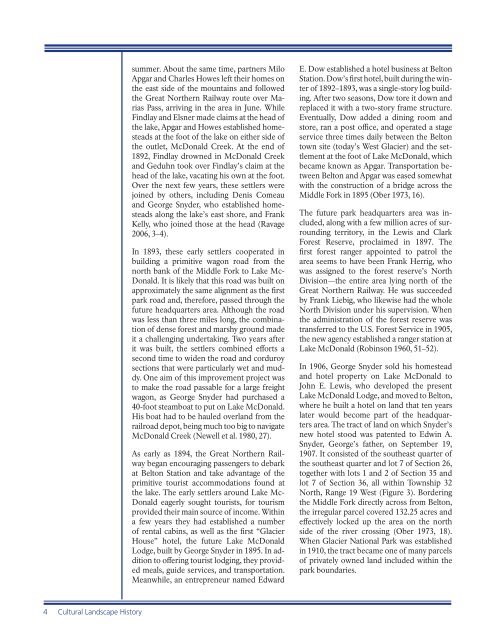At the Foot of the Belton Hills - National Park Service
At the Foot of the Belton Hills - National Park Service
At the Foot of the Belton Hills - National Park Service
You also want an ePaper? Increase the reach of your titles
YUMPU automatically turns print PDFs into web optimized ePapers that Google loves.
4 Cultural Landscape History<br />
summer. About <strong>the</strong> same time, partners Milo<br />
Apgar and Charles Howes left <strong>the</strong>ir homes on<br />
<strong>the</strong> east side <strong>of</strong> <strong>the</strong> mountains and followed<br />
<strong>the</strong> Great Nor<strong>the</strong>rn Railway route over Marias<br />
Pass, arriving in <strong>the</strong> area in June. While<br />
Findlay and Elsner made claims at <strong>the</strong> head <strong>of</strong><br />
<strong>the</strong> lake, Apgar and Howes established homesteads<br />
at <strong>the</strong> foot <strong>of</strong> <strong>the</strong> lake on ei<strong>the</strong>r side <strong>of</strong><br />
<strong>the</strong> outlet, McDonald Creek. <strong>At</strong> <strong>the</strong> end <strong>of</strong><br />
1892, Findlay drowned in McDonald Creek<br />
and Geduhn took over Findlay’s claim at <strong>the</strong><br />
head <strong>of</strong> <strong>the</strong> lake, vacating his own at <strong>the</strong> foot.<br />
Over <strong>the</strong> next few years, <strong>the</strong>se settlers were<br />
joined by o<strong>the</strong>rs, including Denis Comeau<br />
and George Snyder, who established homesteads<br />
along <strong>the</strong> lake’s east shore, and Frank<br />
Kelly, who joined those at <strong>the</strong> head (Ravage<br />
2006, 3–4).<br />
In 1893, <strong>the</strong>se early settlers cooperated in<br />
building a primitive wagon road from <strong>the</strong><br />
north bank <strong>of</strong> <strong>the</strong> Middle Fork to Lake Mc-<br />
Donald. It is likely that this road was built on<br />
approximately <strong>the</strong> same alignment as <strong>the</strong> fi rst<br />
park road and, <strong>the</strong>refore, passed through <strong>the</strong><br />
future headquarters area. Although <strong>the</strong> road<br />
was less than three miles long, <strong>the</strong> combination<br />
<strong>of</strong> dense forest and marshy ground made<br />
it a challenging undertaking. Two years after<br />
it was built, <strong>the</strong> settlers combined eff orts a<br />
second time to widen <strong>the</strong> road and corduroy<br />
sections that were particularly wet and muddy.<br />
One aim <strong>of</strong> this improvement project was<br />
to make <strong>the</strong> road passable for a large freight<br />
wagon, as George Snyder had purchased a<br />
40-foot steamboat to put on Lake McDonald.<br />
His boat had to be hauled overland from <strong>the</strong><br />
railroad depot, being much too big to navigate<br />
McDonald Creek (Newell et al. 1980, 27).<br />
As early as 1894, <strong>the</strong> Great Nor<strong>the</strong>rn Railway<br />
began encouraging passengers to debark<br />
at <strong>Belton</strong> Station and take advantage <strong>of</strong> <strong>the</strong><br />
primitive tourist accommodations found at<br />
<strong>the</strong> lake. The early settlers around Lake Mc-<br />
Donald eagerly sought tourists, for tourism<br />
provided <strong>the</strong>ir main source <strong>of</strong> income. Within<br />
a few years <strong>the</strong>y had established a number<br />
<strong>of</strong> rental cabins, as well as <strong>the</strong> fi rst “Glacier<br />
House” hotel, <strong>the</strong> future Lake McDonald<br />
Lodge, built by George Snyder in 1895. In addition<br />
to <strong>of</strong>f ering tourist lodging, <strong>the</strong>y provided<br />
meals, guide services, and transportation.<br />
Meanwhile, an entrepreneur named Edward<br />
E. Dow established a hotel business at <strong>Belton</strong><br />
Station. Dow’s fi rst hotel, built during <strong>the</strong> winter<br />
<strong>of</strong> 1892–1893, was a single-story log building.<br />
After two seasons, Dow tore it down and<br />
replaced it with a two-story frame structure.<br />
Eventually, Dow added a dining room and<br />
store, ran a post <strong>of</strong>fi ce, and operated a stage<br />
service three times daily between <strong>the</strong> <strong>Belton</strong><br />
town site (today’s West Glacier) and <strong>the</strong> settlement<br />
at <strong>the</strong> foot <strong>of</strong> Lake McDonald, which<br />
became known as Apgar. Transportation between<br />
<strong>Belton</strong> and Apgar was eased somewhat<br />
with <strong>the</strong> construction <strong>of</strong> a bridge across <strong>the</strong><br />
Middle Fork in 1895 (Ober 1973, 16).<br />
The future park headquarters area was included,<br />
along with a few million acres <strong>of</strong> surrounding<br />
territory, in <strong>the</strong> Lewis and Clark<br />
Forest Reserve, proclaimed in 1897. The<br />
fi rst forest ranger appointed to patrol <strong>the</strong><br />
area seems to have been Frank Herrig, who<br />
was assigned to <strong>the</strong> forest reserve’s North<br />
Division—<strong>the</strong> entire area lying north <strong>of</strong> <strong>the</strong><br />
Great Nor<strong>the</strong>rn Railway. He was succeeded<br />
by Frank Liebig, who likewise had <strong>the</strong> whole<br />
North Division under his supervision. When<br />
<strong>the</strong> administration <strong>of</strong> <strong>the</strong> forest reserve was<br />
transferred to <strong>the</strong> U.S. Forest <strong>Service</strong> in 1905,<br />
<strong>the</strong> new agency established a ranger station at<br />
Lake McDonald (Robinson 1960, 51–52).<br />
In 1906, George Snyder sold his homestead<br />
and hotel property on Lake McDonald to<br />
John E. Lewis, who developed <strong>the</strong> present<br />
Lake McDonald Lodge, and moved to <strong>Belton</strong>,<br />
where he built a hotel on land that ten years<br />
later would become part <strong>of</strong> <strong>the</strong> headquarters<br />
area. The tract <strong>of</strong> land on which Snyder’s<br />
new hotel stood was patented to Edwin A.<br />
Snyder, George’s fa<strong>the</strong>r, on September 19,<br />
1907. It consisted <strong>of</strong> <strong>the</strong> sou<strong>the</strong>ast quarter <strong>of</strong><br />
<strong>the</strong> sou<strong>the</strong>ast quarter and lot 7 <strong>of</strong> Section 26,<br />
toge<strong>the</strong>r with lots 1 and 2 <strong>of</strong> Section 35 and<br />
lot 7 <strong>of</strong> Section 36, all within Township 32<br />
North, Range 19 West (Figure 3). Bordering<br />
<strong>the</strong> Middle Fork directly across from <strong>Belton</strong>,<br />
<strong>the</strong> irregular parcel covered 132.25 acres and<br />
eff ectively locked up <strong>the</strong> area on <strong>the</strong> north<br />
side <strong>of</strong> <strong>the</strong> river crossing (Ober 1973, 18).<br />
When Glacier <strong>National</strong> <strong>Park</strong> was established<br />
in 1910, <strong>the</strong> tract became one <strong>of</strong> many parcels<br />
<strong>of</strong> privately owned land included within <strong>the</strong><br />
park boundaries.

















